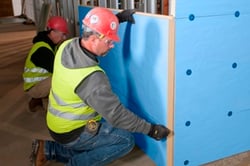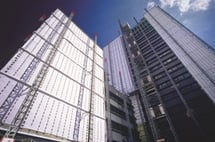Air Barriers: Controlling Air Movement

By: Colin Szewaga, C.E.T., Technical Services Advisor, Air Barrier Association of America
The Air Barrier Association of America (ABAA) is a US-based trade association based in Walpole, Massachusetts. ABAA’s goal is to promote and educate the public on the use, optimum design, installation practices and benefits of air barrier materials and continuous air barrier systems. ABAA is focused on leading the industry into the future in a progressive and professional manner.
ABAA’s membership consists of stakeholders in the building enclosure industry such as air barrier manufacturers, suppliers, distributors, architects, engineers, contractors, researchers, testing labs, inspection and audit agencies, consultants, building owners and managers.
State energy code requirements are becoming more and more stringent driven by factors such as green house gas reduction, an environmentally conscious public, increasing energy costs and the effects of moisture on a building’s durability and service life. ABAA’s role as the voice of the air barrier industry is becoming increasingly apparent.
ABAA’s GOALS
ABAA is the center of excellence in the air barrier industry. The association’s long term strategy revolves around three intertwining goals. First, the association seeks to raise the standard of proficiency in the industry through the ABAA On-Site Quality Assurance Program (QAP), based on the principles outlined in ISO 9000. Second, ABAA will continue to play a pivotal role in the education and outreach of the industry to government, the professional design community, building owners and managers, utilities and other industry stakeholders. Finally, ABAA is dedicated to providing continuing education to the industry. The association offers premier training to air barrier installers,  auditors, as well as AIA accredited courses for design professionals.
auditors, as well as AIA accredited courses for design professionals.
WHAT IS AN AIR BARRIER SYSTEM?
In a nutshell, air barriers control the unintended movement of air into and out of a building enclosure. Air barrier systems are comprised of a number of materials which are assembled together to provide a continuous barrier to air leakage through the building enclosure. The building enclosure includes all six sides of the building and may also include interior separations. This system essentially “wraps” the building shell and ensures protection from the effects of air leakage, which can have detrimental effects on how a building functions and can potentially reduce its life span.
WHY USE AN AIR BARRIER?
A properly functioning air barrier system blocks both air leakage and the diffusion of air caused by wind, stack effect and mechanical equipment pressures.
For the occupants of a building to be comfortable, air is conditioned. In summer, the air is normally cooled and dehumidified to a lower temperature and humidity than the exterior environment. In winter, the opposite is done; the air is heated and humidified to a higher temperature and humidity than the exterior.
When conditioned air leaks out of a building and unconditioned air leaks into a building, additional energy must be used to condition the air. Air leakage can result in increased energy costs of up to 30-40% in heating climates and 10-15% in cooling ones.
Buildings which have a properly installed air barrier system can operate properly and more efficiently with a smaller HVAC system as the mechanical engineer does not have to oversize the equipment to compensate for a leaky building. In some cases, the reduction in mechanical equipment size can offset the cost of the air barrier system.
Air barrier systems also provide a barrier to pollutants entering either the building or its enclosure. Water vapor, suspended particulates, dust, insects, biological contaminants, smells, etc., are all pollutants which need to be keep out of either the building in general or the building enclosure. Water vapor that leaks into the building enclosure (from the inside in heating climates and from the outside in cooling climates) can condensate and form liquid. This water can eventually corrode metals in the building assembly, provide one of the ingredients needed for mold growth, and saturate building materials such as fibrous insulations, gypsum wall board and wood.
Some of the benefits of a properly design air barrier system include:
- Building occupants are more comfortable and protected from drafts, noise and pollutants.
- Mechanical systems can be properly sized and sometimes reduced because they do not have to compensate for air leakage, and the equipment will work more efficiently.
- Greatly reduced moisture transport by air leakage into the wall assembly. Air leakage has the ability to transport exponentially more moisture into and through the building enclosure than occurs through vapor diffusion alone.
BENEFITS OF AIR BARRIERS SYSTEMS FOR OWNERS
The benefits of an air barrier system are many to both the building owners and the occupants of the building. As a building owner, you are able to decrease building operating costs through reduced energy bills, and increase satisfaction of building occupants, which may enhance a building’s rental income potential. Additionally, the long-term durability of a building will increase with a properly designed and installed air barrier system, which will provide for a long life span of the building without major cladding and wall retrofits.
NEW AND RETROFIT CONSTRUCTION
Air barriers can be installed in all buildings, new and retrofit. In new construction, the design of the air barrier is straight forward. Once the design drawings are complete, one should be able to trace a line on the set of building plans to identify the plane of air tightness and air barrier on all six sides of the building without the pen being lifted. This test ensures continuity of the air barrier on the entire building.
If a building is being renovated, air barriers or air tightness strategies can also be designed into the building. This application is not that much different than new building construction. In this instance, the scope of work has to be analyzed to decide whether the air barrier will be installed on the inside of the wall or on the outside. If the cladding is not being removed, but the interior is being gutted, the air barrier can be placed on the inside wall.
AIR BARRIERS IN CODE
Currently, six states require air barriers in their energy code. These include Florida, Georgia, Massachusetts, Minnesota, New York and Rhode Island. ABAA’s website has links to each of these states. In addition, many U.S. states reference either ASHRAE 90.1 or the International Energy Conservation Code for their energy performance requirement. Recent updates to ASHRAE 90.1-2010, ASHRAE 189.1-2010, the 2012 International Residential Code and the 2012 International Energy Conservation Code (IECC) all now have requirements for a continuous air barrier. Look for announcements from your state government and ABAA in the future on their adoption of these codes.
ABAA QUALITY ASSURANCE PROGRAM
ABAA’s on-site quality assurance program (QAP) is the result of a variety of initiatives that provide a level of assurance that a specific product is installed correctly or a specific service is being provided to the highest possible standards. ABAA's QAP is modeled after the standards outlined in the ISO 9000 program and consists of nine components:
• Research and Development of Means and Methods
• Installation Standards and Specifications
• Manufacturer Accreditation
• Contractor Accreditation
• Individual Installer Training and Accreditation
• Project Documentation and Reporting
• Third-Party Audits
• Project Database Tracking
• Impartial Resource for Help
Why Specify the ABAA Quality Assurance Program?
There are many reasons to specify the ABAA QAP on a project. Often, the air barrier assembly is a non-maintainable component of the building enclosure. There is only one chance to ensure correct installation prior to the application of other components in the building enclosure. Repair costs can be up to 60 times more expensive than ensuring proper initial installation. As such, the ABAA QAP makes sure the job is done right, the first time.
Benefits Include:
• Decrease in liability for the design professional
Assurance that the installation meets the specification requirements
• Providing the best for your client in an emerging industry
• Support from an impartial body
• Detailed records of each project from start to finish
• Assistance in project discrepancies
• Technical resources for architects
Any project that incorporates the ABAA QAP will receive the following:
ABAA Accredited Contractors: Only contractors who have met ABAA's mandatory quality assurance and training requirements are awarded accredited contractor status. These contractors have completed air barrier training, are required to sign a licensing agreement to ensure professional conduct and are obligated to meet the requirements of the QAP on a continuous basis. (put accredited logo here)
• ABAA Certified Installers: Individual installers are required to complete leading-edge training programs designed to provide them with the skill sets required to perform air barrier installations to the highest degree of quality. Installers are also required to sign a licensing agreement to ensure professional conduct and are obligated to meet the requirements of the QAP on a continuous basis.
• On-Site Quality Control: Installers are required to undertake quality control measures on a daily basis. They have completed air barrier training and utilize equipment to inspect and test the quality of their work to ensure it conforms to the standards outlined in the QAP.

Documentation and Reporting: The installers document the entire installation process on daily job site reports. These reports include information on the installer, substrates, substrate preparation, products used, ambient and substrate temperature, the location of the air barrier installation, the results of their quality control procedures and testing results. Every job site report is reviewed by the QAP managers and added to the project database.
• Third-Party Audits: Audits take place on every project that specifies the ABAA Quality Assurance Program. Independent third-party auditors review adherence to the QAP, installation instructions, manufacturers' recommendations and the overall quality of the installation of the air barrier. A report is then provided to the design professional and the building owner. The minimum number of audits ABAA will conduct is based on the total square footage of the air barrier material that is being installed. Additional audits may also be conducted, and the design professional may specify as many audits as they wish over and above the ABAA minimum.
WHERE TO START
All managerial, technical and administrative aspects of the ABAA QAP are handled by third-party organizations. Everything from accreditation, audits, conflict resolution, paperwork review and the assessment of demerit points are handled through this impartial organization. All members must demonstrate and maintain a high quality of workmanship to be associated with the program. To find an accredited ABAA contractor, manufacturer, distributor, design professional or building envelope consultant in your area, visit www.airbarrier.org. The ABAA website also provides a plethora of information including CAD details, technical information, master specifications and other design information for the design professional.
Colin Szewaga, C.E.T., is the Technical Services Advisor with the Air Barrier Association of America. Colin assists industry members such as architects, engineers, contractors, air barrier installers and building officials on the proper design, installation and further requirements of air barrier materials and systems. Colin is a supporter of local air barrier and building science learning opportunities by assisting in the development and planning of educational events and conferences. He can be reached at 1-866-956-5888 or cszewaga@buildingprofessionals.com.
Subscribe Today!
Stay-in-the-know and subscribe to our blog today!